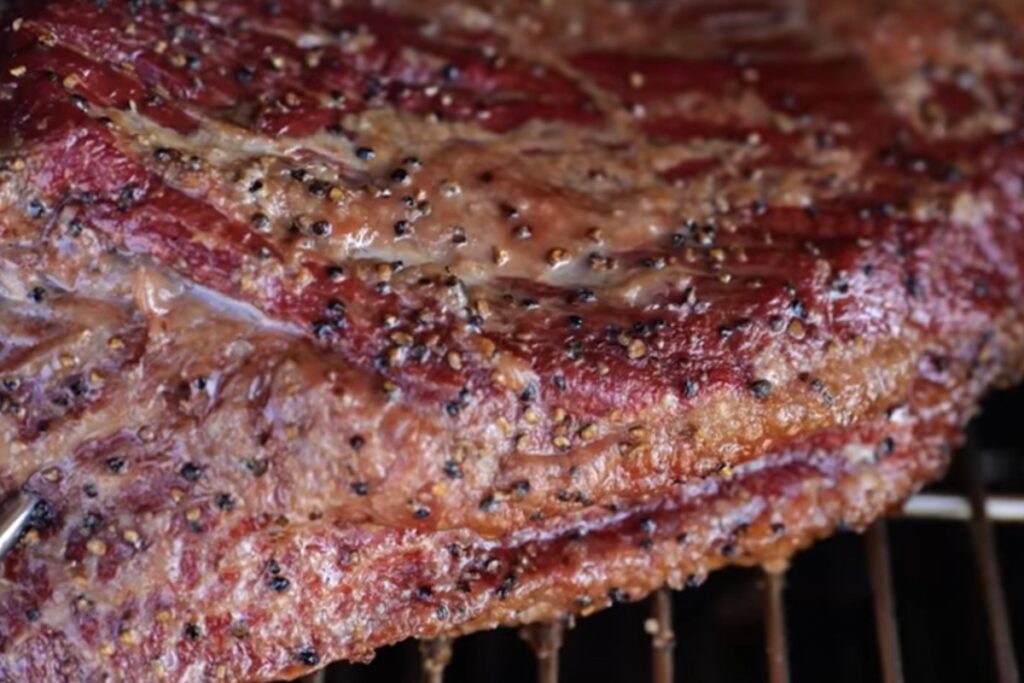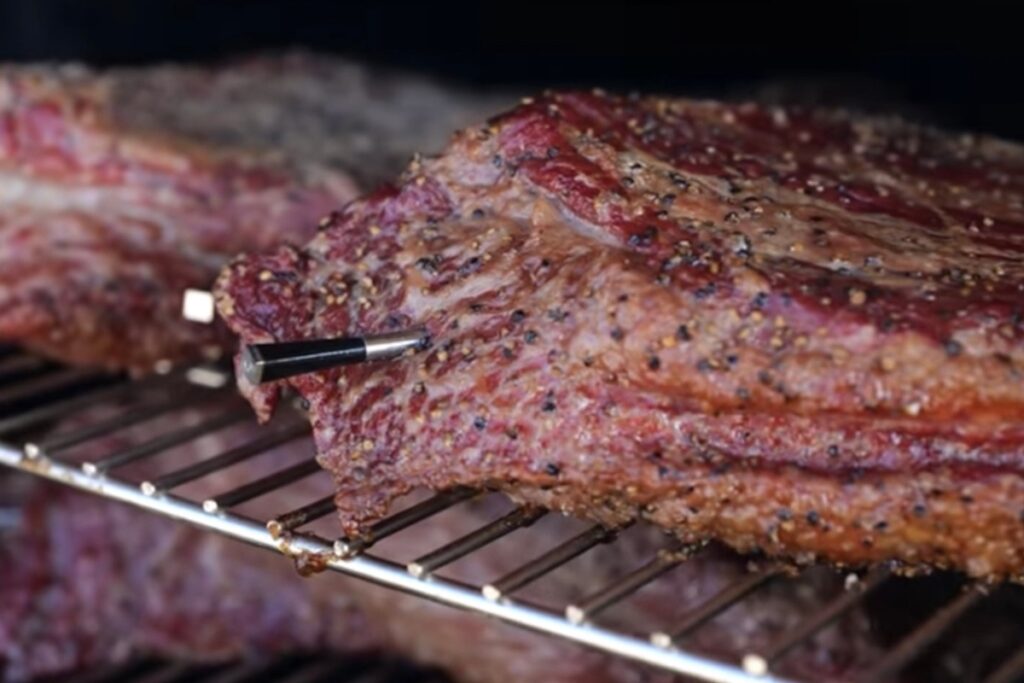Great brisket needs time, not just the preparation and the smoking but time to rest. Find out how to rest your brisket after smoking and why you should.
Tempting isn’t it. You’ve taken the trouble of smoking your brisket and it smells so good. There are hours of prep and keeping the meat covered in a rub overnight. That’s even before at least six hours of smoking. You just want to start slicing it up.
What if after all that time you succumbed to temptation? Sure, the meat is cooked but you’ve missed a vital step. That elaborate process is almost done. Almost. Slicing it now would be a mistake, and you cannot turn back time.
Just give it a few more hours or so. Don’t undo your hard work and that elaborate cooking process you just went through. We’ll guide you through that final step of resting your brisket after smoking. We’ll even explain why you should.

How To Rest A Brisket After Smoking
Resting is a crucial part of the brisket process. Arguably, the cooking is the main part yet resting can make all the difference. It can also be the most straightforward aspect of the experience.
Most of the problem is simply willing away the time. Simply leaving the meat alone is the tricky bit. However, there are several reasons why you should rest your brisket after smoking which we’ll get to.
Remember The Carry-Over Cooking
Ideally, you want to stop cooking the brisket once that water starts to be released. Most briskets should be just right when the internal temperature hits 200 F. Maybe even sooner. Even after removing from the heat, the meat is still cooking and the temperature is still rising.
This is called carry-over cooking. To prevent it simply remove the brisket before it hits the 200 F mark. At that mark, the interior of your brisket should have that delicious, tender texture you took the time to create.
That carry-over temperature should rise by about 10 degrees. If you remove the brisket as the temperature hits 190-195 degrees you should avoid the rest of the piece overcooking.
That’s the when, how about the how? Resting brisket for hours means that the internal temperature will gradually drop. Once the brisket is removed from the smoker, remove any covering material. That includes any butcher paper. You should place the brisket on a platter or chopping board.
Now that it’s in place you only want to cover the brisket loosely with a piece of aluminum foil to avoid those juices evaporating. Resting is important but so is keeping the brisket warm and a loose covering of aluminum foil should keep enough heat in.
This foil top may also soften the bark on your brisket yet this is a small price to pay. Especially when you consider how moist the meat will be. Don’t wrap the brisket tightly as the meat will continue to cook. If you’ve got friends over for a barbeque then the rest time should be at least an hour.
That’s if you’re in a hurry. If they can wait, give it two hours. After that amount of time, it should be ready for a group to dig in and eat straight away. You could check the internal temperature and wait until it hits that sweet spot which may be three, perhaps even four hours depending on size.
Any longer after that and the meat may begin to cool at a more rapid rate. Once that two hours is up, you could be left with an unpleasantly cold piece of meat. You really do not want to be reheating it either as that’ll dry the brisket out.

Using An Insulated Dry Cooler
If you can factor in even more time then consider using an insulated dry cooler. Once you’ve removed the brisket from smoking, you can wrap it in butcher paper then a few towels. A well-smoked piece of brisket can remain warm for hours which should be considered. You want it thoroughly rested yet still warm for slicing.
Place that well-wrapped brisket into a cooler and it can keep for around two to four hours. This also gives you a bit more leeway if you know your guests are going to arrive a bit later. But what if they arrive early or your brisket takes longer in the smoker?
Once you know when it needs to be ready, take it out of the cooler and leave it on the side with a loose covering of aluminum foil. Then you only need to give it an extra hour (usually at least an hour) though you can check the internal temperature to get it just right.
There’s even more science. However long you decide to rest your brisket after smoking, ideally, you shouldn’t let it drop below 150 F. Why? That’s the perfect temperature to slice it once unwrapped.
Alternatively, you could judge your brisket by how it feels. Don’t ask it. You just want to probe it. The brisket should feel as soft as butter with a little jiggle. That’s when you’ll know it’s ready to be sliced and served.
Why You Should Rest A Brisket After Smoking
If you’re new to smoking, you should know that a well-rested piece of brisket needs time. If you’re going to spend time (and money) with a smoker you shouldn’t be rushed. Any carnivore should value the effort that’s gone into preparing brisket.
Even if your hungry guests have been invited over and have to wait a bit longer. You’ve been patient enough to smoke your brisket, a few more hours makes a worthwhile difference.
Now for the science bit. Like most meat, a piece of brisket is mostly water, around 70%. You want to keep as much of that moisture in as possible. The smoking process results in that water rising to the surface. This is from within the meat fibers.
Brisket is a lean cut of meat and the cooking causes the muscle fibers to contract. This contraction forces moisture towards the middle as well as the surface of the brisket. With that moisture on the move, the interior of the brisket will be left dry. Resting helps stop that.

Resting a brisket for a few hours results in the tenderest meat. Those delicious juices are also retained. The process has a lot to do with thermodynamics. Once the brisket has been removed from the heat it begins to relax. Out in the open at room temperature, the temperature slowly drops.
The exposure to moving air also helps the resting process. Inside the brisket, the juices start to redistribute themselves. Crucially, those juices stay in the brisket and they also start to thicken which helps each slice become succulent.
You want those juices to be as thick as can be. By resting the brisket the meat cools. The proteins inside are now dissolved and can mix with the juices making them even thicker.
The Importance Of Collagen
Let’s explain how that happens to explain why resting is so crucial with brisket after smoking. A piece of brisket should contain a lot of collagen, this specific protein dissolves during an extensive cooking process such as smoking.
Once the brisket has been removed from the heat, that collagen can now start to firm up again. Effectively, the collagen acts as a thickening agent with the rest of the brisket’s juices. This process needs time. The longer the brisket has to rest, the longer the collagen has to thicken up the juices.
Without the time taken to rest, should you take a slice off the brisket the juices will escape. Not only have you now allowed the collagen to do its magic, but the steam has also gone too. You cannot recapture steam and force it back into a piece of brisket.
The texture isn’t quite as tempting and the meat will become tough and dry sooner than you want. The worst part is that a lot of the potential flavor that you took so much time over has gone. You don’t want to try and collect the liquid and force it back in.

You don’t want to find out how much moisture you’re set to lose by not resting your brisket. Not by your own personal experience. If you were curious, it’s actually quite a lot of moisture. As much as ten tablespoons of liquid can be lost if a meat joint is cut into immediately after cooking.
You’d also be serving a really hot piece of meat. Try to measure ten tablespoons. That’s a lot of excess liquid. Now imagine that it stayed in your brisket. Imagine how much juicier it would be.
Even cutting into it after ten minutes can result in four tablespoons of lost moisture. That’s still a lot. However, if you were to wait 40 minutes then that amount can be down to as little as a single tablespoon.
Brisket can be such a flavorsome piece of meat. It can also be deliciously tender and resting is a huge part of that. Without resting you can be left with a dry, tough piece of meat. Slices would also be chewy to the point that your barbeques get a bad reputation.
You want those juicy fats and collagen remaining in your brisket so keep them in and keep that good reputation. For a long-lasting, delicious piece of brisket, resting is crucial.
What Happens If You Don’t Rest A Brisket After Smoking?
Put bluntly, you’ve wasted a lot of the effort that went into preparing and smoking the brisket. Show it some respect by letting it rest and you will be rewarded.
If you fail to rest the brisket, you will be met with disappointment. That’s because even after removing the brisket from the smoker it’s still cooking. Dry, tough meat when what you were really after was tender and juicy. All because you couldn’t wait a few hours.
Final Thoughts
Patience is a virtue and one that’s richly rewarded when barbequing. Any large cut of good quality meat deserves time and will definitely be a benefit. There are several stages to producing a high quality, winsome piece of brisket. Hours will go into selecting the right piece, concocting then applying the meat rub.
The smoking may take the longest time yet the resting is time well spent. Knowing how to rest a brisket after smoking goes a long way into bringing out the most flavor. Sure, your guests may moan and they may even challenge your wisdom.
If anyone asks why they’re still waiting you should be able to explain why you’re leaving it alone instead of slicing. Time management is crucial to any cooking, especially when smoking a brisket.
Remember, we cook to an internal temperature, and only when its time has been served is it ready. Give it an hour or two to give you and your friends the tenderest, most flavorful meat.
- Is Blue Steak Safe To Eat? - May 7, 2022
- How To Tell If Your Bratwurst Sausage Is Cooked - May 7, 2022
- The Internal Temperature For Tri Tip When Done - May 7, 2022









